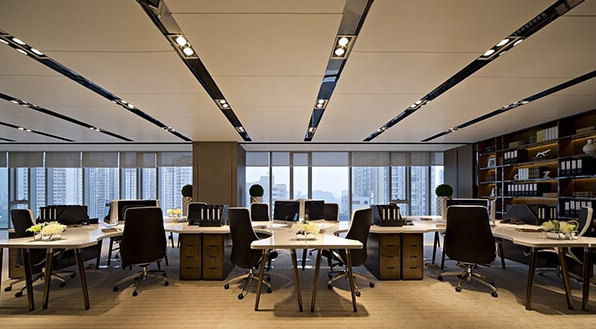
The office is used for work, the purpose of work is to create wealth, and the working environment, especially whether the lighting quality is reasonable, will directly affect the enthusiasm, efficiency, and even safety of employees. Imagine if you sit in a room with insufficient light (including too bright light or glare) all day, facing the computer, will you feel easy to visual fatigue, physical fatigue, or even headache, dizziness, and vomiting in severe cases , Eye irritation, dryness, fatigue, redness, inflammation, blurred vision, decline, myopia or deepening of astigmatism, etc. Therefore, a good, scientific and reasonable office lighting design is very important.
So, how to avoid these problems in office lighting design? Wotian lighting design summarizes the following 4 main points:
1. The illumination should be sufficient and uniform
Generally speaking, we find that the most common mistakes in office lighting design are unreasonable light distribution, insufficient illumination or uneven light distribution. The consequence of this is visual fatigue, physical fatigue, and headaches, which can lead to inability to concentrate and affect work efficiency. At the same time, if the intensity of the light in the background (the space facing away from the work area) is too high, it will cause the computer screen to receive a lot of reflections, which will also make the employees’ eyes stay in a state of “looking for things on the screen” for a long time. Fatigue will definitely come faster.
2. Mainly use warm white light
I don’t know if you have noticed that in order to highlight the modernity, technology, and cleanliness of the company, some companies like to use white light or even strong white light for lighting. There is nothing wrong with this idea, but in fact, from a scientific point of view and In terms of the rationality of the lighting design, it is not recommended to choose office lamps with too high color temperature. We recommend that the office lighting is as close to natural light as possible.
From 3200K upwards, the characters will feel more and more uncomfortable. Therefore, when choosing office lamps, in the choice of the color temperature parameter, we recommend choosing 3000-4000K, too high or too low is not appropriate.
3. Avoid glare
Whether it is commercial lighting or home lighting, glare must be absolutely avoided. Regarding the hazards of glare to vision and health, I won’t go into details here. Whether it is sitting or standing, the lighting design of the lamps can be seen from the head-up direction, which is not a good design. “Seeing the light but not the light” is the goal that a reasonable lighting design must pursue. It is recommended that at the beginning of decoration design and lighting design, it is necessary to fully consider issues such as station layout, lamp selection, illuminance calculation, and installation angle.
4. Smart dimming
From the beginning of the office planning stage, some companies have adopted smart lighting control solutions to reduce overhead direct lighting and intelligently adjust the lighting according to the environment. This method can not only prevent reflections on the computer screen, reduce the impact of computer vision syndrome, improve job satisfaction, and reduce stress. It can also save a lot of costs. Because the abundant sensor equipment allows you to understand the office environment in a comprehensive and real-time manner; time-delay switch tasks, energy saving and environmental protection, as energy costs continue to rise, this can help save unnecessary expenses.
